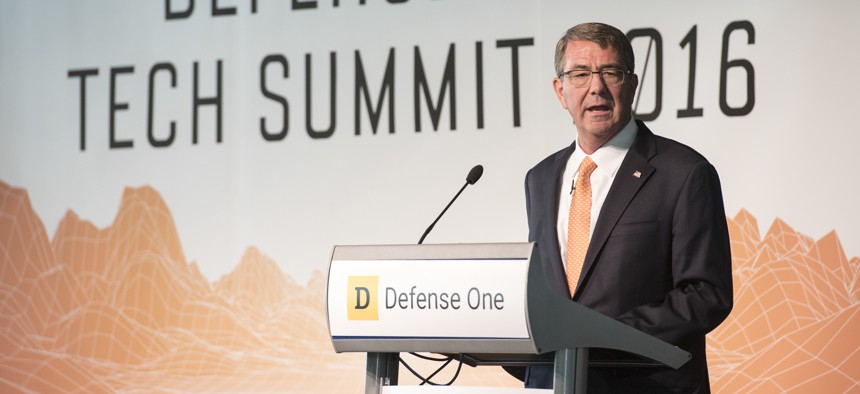
Secretary of Defense Ash Carter speaks at the Defense One Tech Summit in Washington D.C., June 10, 2016. DoD / Staff Sgt. Brigitte N. Brantley
Ash Carter’s Lasting Legacy
The former defense secretary leaves behind a much stronger Pentagon-Silicon Valley relationship.
“We need to give the future a seat at the table,” Secretary Ash Carter told me soon after President Obama nominated him to be Secretary of Defense. “Remind me that every day.”
It was a bold statement. I was briefing Secretary Carter in my role as Deputy Assistant Secretary of State for Middle East policy. In January 2015, the incoming Secretary’s inbox was a full as anyone’s who had ever walked into the E Ring. He was simultaneously grappling with the terrorist threat of ISIS, state collapse in Syria, a belligerent and potentially nuclear Iran, crisis in Yemen, and war-weariness in Congress and among the American people. And that was not even counting his briefings that afternoon about tensions in China, Taiwan, North Korea, Russia, and Crimea. Crisis management could easily consume his entire term.
But Secretary Carter knew he had to do more. I had lived in Silicon Valley and graduated from Stanford, where he had immersed himself in his time out of government. He asked me to join his transition and confirmation team, to help him focus on these broader priorities. His goal was clear: harness American innovation to equip America’s defenders—now and into the next generation.
He was impatient and acted quickly. In the first weeks in office, he convened top entrepreneurs and CEOs of cybersecurity and emerging-tech companies for private dinners in his office. His question was: What is stopping the best technology from coming into the government? Why are Silicon Valley and Washington fighting their own Cold War? He listened as his guests described the Defense Department as a difficult customer. He learned how hard it was for patriotic engineers to serve our country in uniform or as civilians.
On his military transport plane to Afghanistan on his first trip as SecDef, Secretary Carter put in motion two initiatives. He established the Defense Innovation Unit, setting up outposts in Silicon Valley, Boston, and Austin to help the Department obtain cutting-edge technologies. In five years, DIU has awarded nearly $900 million in contracts to nearly 250 companies, and spurned a new crop of offices dedicated to innovation in nearly every part of the Pentagon. He also designed a program to recruit the best talent into the Pentagon, in uniform and civilians, in the way same way he was called to Washington as a physicist in the 1980s to wage nuclear diplomacy with the Soviets.
He never stopped trying to find new ways to connect to American innovators. He established the Defense Innovation Board, and recruited Alphabet’s Eric Schmidt to chair it. He made regular stops at startups around Silicon Valley. He was the inaugural speaker and a founder of the Defense One Tech Summit. Reclaiming America’s lost technological edge was an obsession for him, or as he put it: being not only “the Secretary of Defense of today” but also “the Secretary of tomorrow.”
And he never stopped trying to apply new ideas to winning the next war. On one trip to Israel, Secretary Carter and I received a highly classified briefing about cyber technologies. With no one else briefing him, he immediately suggested ways these technologies could change our war planning. I saw this kind of thing happen again and again, identifying how technology could detect smuggling tunnels in Gaza; how small drones could become effective tools of war; how Israeli innovation could turn food and water security into far-longer-term security issues in the Middle East.
Today, Secretary Carter’s fingerprints are all over the central role technology plays in America’s defense vision. The CHIPs Act advances America’s competitiveness. President Biden’s recent Executive Order on Biomanufacturing puts innovation at the heart of national security. The recently released National Security Strategy elevates these to the central element of U.S. foreign policy.
And his legacy lives on in a much stronger Pentagon-Silicon Valley relationship. When I worked in venture capital on Sand Hill Road early in Secretary Carter’s tenure, defense-technology plays were rare; investing in cryptocurrency or software sold to the Fortune 500 promised better returns. But today, top venture investors are leading investments in drones, artificial intelligence-enabled tools, and next-generation technology. Defense technology players like Palantir, Anduril, Shield.ai, and Rebellion Defense have gone from startups of a few people to powerful companies worth billions of dollars.
Ash Carter’s most passionate commitment to the future was as a tough and loyal mentor and teacher. When I sought advice on my career, he somehow found time to take me on his familiar long walk around the Pentagon corridors. His vision of defense and technology integrated in service of a larger mission inspired me and so many others to build a career between government service and technology in the private sector. As a teacher and boss, his questions were probing and his standards the highest. When I have taught classes inspired by him, on the politics of policymaking, or Hacking for Defense, I hear his voice. Is this memo ready for the President? Is this the best solution? Have you looked at everything?
He has gone suddenly and too soon. I think with sadness that the next generation of national-security leaders will not hear his voice. But his legacy will continue to guide them.
Matt Spence served as Deputy Assistant Secretary of Defense for Middle East policy from 2012 to 2015, and on Secretary Carter’s confirmation and transition team in 2015. He is currently professor of practice at Arizona State University and Managing Director and Head of Venture Capital Banking at Barclays.




